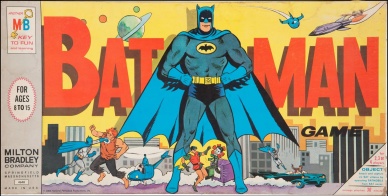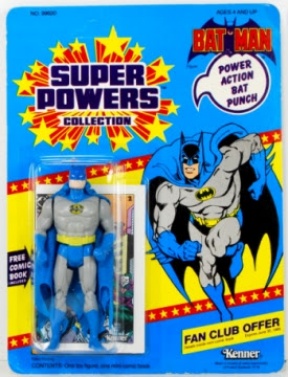This month marks the 75th Anniversary of Batman, and it’s got us thinking about the Caped Crusader a lot these days. And we’re not alone. We’ve seen some stellar pieces discussing the character’s longevity, and of course, the obligatory rankings of the best Batman comics and movies. But what stands out to us more than anything is Batman’s reach outside of comics. He’s one of the most recognizable fictional characters on Earth, and responsible for generating mass amounts of memorabilia every year. With that in mind, we thought we’d look back at some of the most interesting and important Batman toys and games of the character’s first 75 years. Feel free to share your favorites in the comments.
Note: our list won’t be including any Batman-themed guns, because… well, Batman hates guns, and we hate writing about them. Nor will it cover any international Batman toys. Seriously, we have to sleep sometime.

Batman & Robin Full Color Transfers (1944)
Just five years after his 1938 debut in the pages of Detective Comics #27, DC Comics (then Detective Comics, Inc) produced this set of Batman transfers, featuring not only the Dark Knight and the Boy Wonder, but some of his greatest foes and a few of his best gadgets. Transfers, for you Millennials out there, were basically kind of like temporary tattoos, except you didn’t put them on yourself. They were little wet stickers you could put just about anywhere, and while that might not sound that exciting today, you can bet your tights they were all the rage in ’44. Think about it: for the first time, kids could literally create their very own Batman adventure without chopping up their comic books. This is one of the earliest examples of kids lifting Batman’s adventures off the page and into their own hands. And because they debuted in the earliest days of fandom, they’re some of the most sought after Bat-souvenirs around.

Batman Board Game (1966)
Jumping ahead a couple decades to the 1960s, we find ourselves right smack dab in the middle of the Batmania brought on by the Batman ’66 TV show. Batman was everywhere, and his smiling face on everything, and one of the most popular items of the day was Milton Bradley’s Batman Board Game. Appropriate for ages 8 to 15 (check the box!), the Batman game featured Batman and Robin making their way through an oddly futuristic Gotham, solving crimes and facing off against the likes of the Joker, Penguin, and Blockbuster.

Batman Bop Bag (1966)
I’m not exactly sure I get the appeal of this one. As a fan of Batman — and therefore, presumably, someone well acquainted with his prowess as a fighter — why would you ever want to punch him? I mean, admittedly, there’s some pretty good bragging to be done with this one. “Hey, Skip, so guess who I just gave a beatin’ to!” But if I’m being honest, I would suspect any kid super into this toy was firmly set on a path to their hometown’s equivalent to Arkham Asylum. Look, I know, I know, some of you see this and think, “Oh, but it’s good exercise.” Sure. You call it “exercise.” I call it “Joker practice.”

Batman Pez Dispenser (1967)
Batman and candy! Could there be anything better?
Another product of the ’60s Batman craze, Pez’s Batman stands out in the crowd thanks in part the candy maker’s decision to add an awesome little cape.

Mego Batman (1976)
With memorable appearances in Twisted Toyfare Theater and on numerous episodes of Robot Chicken, Mego’s Batman (the one here, with the molded head) is maybe the most recognizable toy on this list. It really is a great toy, with a unique look and feel all its own, while still being distinctly Batman. Mego’s foray into toys basically created the first superhero action figure, and Batman is considered by many to be the pinnacle of the line.

Ben Cooper Batman Halloween Costume (1976)
“I’m Batman! At least until the suit tears or the elastic band on my mask pops!” Still, despite a few obvious design flaws, this Ben Cooper Batman Halloween costume was pretty rad, and is fondly remembered for having a lot of that Ben Cooper “almost-getting-it-right” appeal. You can guarantee this one saw justice dealt out to countless suburban neighborhoods all year round.

Super Powers Batman (1984)
Mego introduced the superhero action figure, but Kenner nearly perfected it with the Super Powers Collection. Wave One featured most of DC Comics’ most recognizable heroes, and they all looked undeniably cool, but Batman was downright amazing. For the first time, kids had a version of Batman that was both comics-accurate and supremely playable. What he lacked in Mego-style articulation, Super Powers Batman made up for it in dead-on sculpting, a sweet removable cape, and a cool Karate-like action feature. Equal parts Carmine Infantino and Jim Aparo, this Batman looked like he’d just stepped out of an issue of The Brave and the Bold, fully intending to kick some ass. Mego Batman was a nice reminder of that old TV show, but Super Powers Batman felt like the Batman toy you’d only dreamed about.

Shadow Wing Batman – Batman Returns (1990)
I’m not breaking new ground when I say ToyBiz’s Batman (1989) toys sucked. Seriously, the line had only three figures, and one of them was Bob, the Goon. Who thought that was a good idea? Thankfully, by the time Batman Returns landed in theaters in 1990, the Batman toy license fell back into the hands of Kenner, who then proceeded to show ToyBiz how its down with Shadow Wing Batman. See, the major complaint against ToyBiz’s Batman offerings were the poor likenesses. But Kenner put any concerns about likenesses to rest with this one figure, as Shadow Wing Batman likes like Michael Keaton’s Batman, and perfectly mimics one of the film’s most memorable scenes. This awesome toy — and the Batman Returns line as a whole — represents something of a course correction for Batman toys, and sets the bar for just about every superhero toy that follows.

Combat Belt Batman – Batman The Animated Series (1992)
Kenner does it again! Batman: The Animated Series is the greatest superhero show of all time. Tonally, and conceptually, it accomplishes more in its first few episodes than most TV does in three or four seasons. And Combat Belt Batman — or just call him “basic” Animated Batman — captured the aesthetic of TAS co-creator and head designer Bruce Timm perfectly. This figure is beautifully sculpted, and manages to evoke the simplicity and complexity of the show, while still being a really fun, and a cool toy to look at. More than any Batman toy before, this figure looks and feels precisely like the thing that inspired it, and in doing so, sells the concept even more. It’s an superb 3D representation of a hugely successful and widely accepted look that would define DC’s characters in animation for the next two decades, and seeing it off the screen had a real impact on me when I was a kid.
I’ve heard some people say it sacrifices poseability in favor of show accuracy, but they’re pretty dumb to say that (and I’ve never heard a kid say that.) Truthfully, in today’s market, this figure would be one of the most prized art-toys around, but in 1992 he was simply the coolest Batman on the pegs.

Silver Age Batman & Robin – DC Direct (2002)
In 1998, DC Comics launched DC Direct, an in-house toy making arm that sold action figures and props to the direct market. One of DC Direct’s earliest statements mentioned they would shy away from making toys of characters already being produced for the mass market, figuring people needed another Superman or Batman toy like they needed a whole in the head.
Fast forward several years, and DC eventually realized the demand for specialty figures based on their most popular characters was high enough to warrant doing something about it, and they released the Silver Age Batman & Robin Deluxe Action Figure Set. This set is significant for two reasons: 1) Batman and Robin’s look were based on the artwork of classic, “New Look” Batman artist Carmine Infantino, kicking off the very lucrative practice of DC creating toys and statues inspired by the art styles of specific comic creators. And 2) the figures’ sculptor, Tim Bruckner, began to gain wider recognition as an artist in his own right, leading the way for DC and other premium figure companies to start crediting the previously unknown sculptors and/or design teams on a toy’s packaging.
Continued below
Lego Batman (2006)
Lego is the biggest toy brand in the world. Batman is the world’s most popular superhero. Why did it take these two so long to get together? Lego started producing licensed Batman sets in 2006, and hasn’t stopped since. The Lego Batman brand has since inspired video games, animated specials, spinoff lines such as Lego DC Superheroes and Lego Marvel Superheroes… and most memorably, Batman’s role (voiced by Will Arnett) in last year’s The Lego Movie. DC’s partnership with Lego is a shining example of two major companies working together to create something both of their audiences can get into, and in this case, something even cooler! Now if we can just get some Lego Batman comics…

Batman Arkham Series Video Games (2011 – Present)
I’ll admit, I’m not a video game guy, but even I couldn’t ignore the juggernaut that was Batman: Arkham City. Batman’s had video games before, but they’d never captured the character and the world he inhabits quite like Arkham City did. Mixing cinematic aspects of Christopher Nolan’s Batman films with the mythology and characterization of the comics, the game offered fans a chance to step into a hyper-realized world that brought them closer to the Dark Knight than ever before. And the two sequels, Arkham Origins and Arkham Knights, have only continued the series’ popularity. While some might question if these are actually toys are not, the Arkham games are, without a doubt, the most popular Batman experience going right now, and it’s way more likely your 12 year old nephew’s playing Arkham City instead of playing with this:




